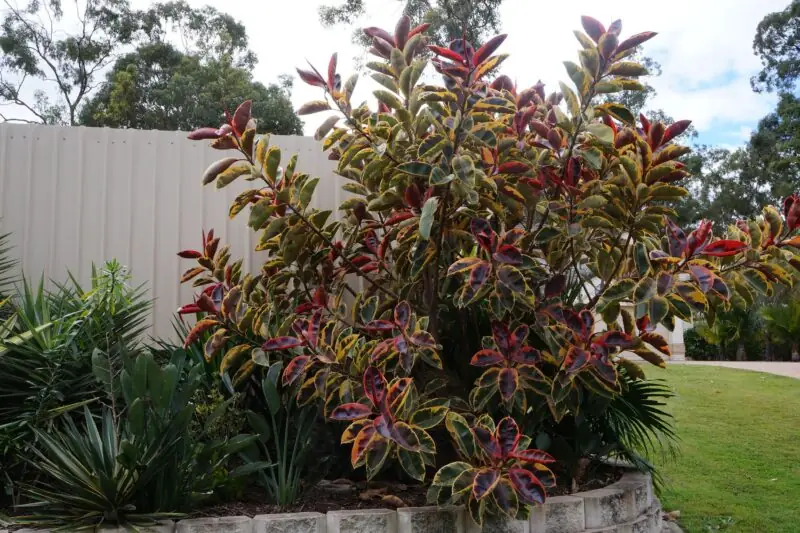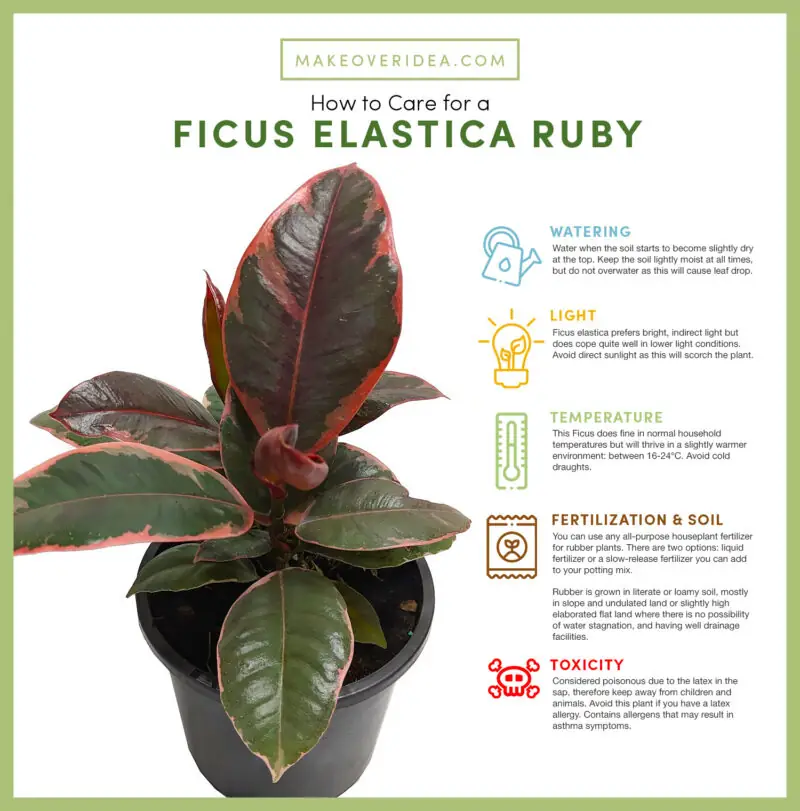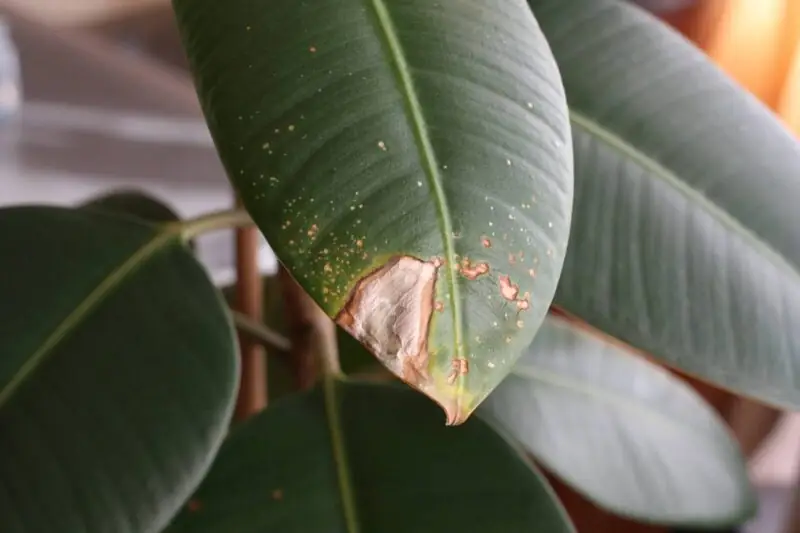Ficus Elastica Ruby: Care Guide to Your Beautiful Plant

Are you looking for a vibrant and easy-to-care-for houseplant that will brighten up your living space? Look no further than the Ficus Elastica Ruby! This tropical plant, also known as the Variegated Rubber Tree, is an eye-catching addition to any indoor garden. In this article, we’ll provide all the information you need to care for your Ficus Elastica Ruby successfully.
About Ficus Elastica Ruby
The Ficus Elastica Ruby is characterized by its variegated foliage with striking shades of pinkish-red mixed in with greens and yellows. This colorful display makes it stand out from other rubber trees commonly found indoors. It’s a relatively low-maintenance plant that can grow up to 10 feet tall when provided in ideal conditions.
History and Origin
Ficus elastica ruby originates from India but has become popular worldwide due to its hardiness as an indoor plant species. The ancestor of this stunning hybrid was discovered in India around 1811 by Nathaniel Wallich, the director at Calcutta’s Botanical Garden, who described it scientifically under several names before finally settling on “Fimus elastia” (Elastic Fig).
In recent years, growers have developed many varieties through crossbreeding programs aimed at producing plants with unique variegation or dwarf cultivars suitable for smaller spaces.

Light and Temperature Requirements
Optimal Light Conditions
The best light conditions for ficus elastica ruby are bright indirect sunlight or morning sun exposure filtered through sheer curtains; direct sun rays could burn leaves harming them permanently. Place your ficus near an east-facing windowsill where they get plenty of natural light but not too much heat during the hot summer months. If there isn’t enough natural lighting available inside your home, then fluorescent bulbs are good alternatives because they emit UV-free artificial lights that mimic sunshine without damaging the leaves’ sensitive tissues over time.
Ideal Temperature Range
The ideal temperature range for Ficus Elastica Ruby is between 60°F to 75°F degrees. They can tolerate temperatures below or above these ranges, but prolonged exposure could affect their growth and health. It’s important to protect your plant from sudden changes in temperature; avoid placing it near cold drafts such as windowsills during winter months.
Water and Humidity
Watering Schedule
Water the ficus elastica ruby once a week thoroughly, allowing water to drain out of the pot bottom before returning it back into its saucer. Overwatering could lead to root rot, so make sure the soil dries out completely before watering again.
Importance of Humidity
Ficus Ruby prefers high humidity levels ranging from 50% to 70%. Dry indoor air could cause brown leaf tips or edges, indicating low humidity levels inside your home.
An effective way of increasing moisture around plants is by using humidifiers indoors; alternatively, you can place bowls filled with wet pebbles or rocks underneath pots, especially during dry seasons like winter when heating systems lower natural indoor air moisture content significantly.
Tips for Maintaining Proper Humidity
If you live in areas where there’s dry weather most of the time, misting leaves daily using spray bottles filled with tap water (preferably room-temperature) helps restore lost atmospheric moisture around them, ensuring continued healthy foliage growth. Another option is adding decorative pebble trays under houseplants, which allows excess water to collect, thereby creating extra humidity naturally over time, providing a suitable growing environment for plants.
Soil and Fertilizer
Best Soil Mix for Your Ficus Elastica Ruby Plant
When planting ficus elastica ruby, use well-drained potting soil mixed with perlite (1:1 ratio). This will ensure adequate drainage, preventing fungal infections that often occur on poorly drained soils.
Fertilizer Recommendations and Schedule
To maintain optimal nutrition balance, fertilize your plant every three weeks with liquid fertilizer, especially during spring and summer months when they actively grow most. You can skip feeding your plant in winter since the lack of daylight affects their metabolic rates.
Ficus Elastica Ruby vs. Ficus Elastica Tineke

Key Differences
To distinguish between the two plants, check for color variations such as bright pinkish-red on leaves; this is a clear indication that you have ficus elastica ruby – sometimes referred to as a variegated rubber tree. Ficus elastica tineke has dark green foliage streaked with white or cream, which stands out from the colorful leaves of its cousin.
Care Similarities
Both species require similar care instructions, including high humidity levels, moderate exposure to bright indirect light filtered by sheer curtains, and watering schedules allowing the soil to dry up completely before the next watering while avoiding overwatering altogether.
Ficus Elastica Ruby: Problems and How to Solve Them
Yellowing Leaves
Causes
Yellowing leaves could be an indication of several factors, including underwatering (dry soil), nutrient deficiencies, or infestations such as spider mites and thrips damaging leaf cells leading to yellow pigmentation within them, resulting in visible yellow spots or patches across affected areas.
Solutions
Check if your potting mix dries up too quickly, indicating insufficient water uptake by roots, then adjust accordingly based on changing moisture needs observed over time. Alternatively, consider using fertilizers specifically formulated for tropical houseplants like ficus elastica, rich in essential macro and micronutrients critical for healthy growth habits without causing root burns due to excessive salt contents affecting absorption rates negatively.
Browning Leaves
Causes
Browning occurs when leaves lose moisture content more than usual, leading to wilting followed closely by burnt edges and dried-up tips indicated visibly all around impacted tissue parts until dead brown spotted patches appear covering entire leaf surfaces and slowly killing them off entirely given enough time passes unless addressed promptly.
Solution(s)
- Check soil moisture levels and adjust accordingly based on changing ambient temperatures and humidity ratios observed over time using watering schedules described earlier to establish regular routines that work well for your specific plant species’ requirements.
- Use humidifiers indoors or place pot trays filled with pebbles under ficus elastica ruby houseplants, increasing humidity naturally around them without causing root rot from standing water accumulation and inducing infections in the long run.
- Cut off dead leaves to prevent energy drain away from healthy foliage growth habits needed now more than ever during critical periods when they require increased nutrient uptake rates.
Diseases and Pests

Identifying Common Diseases
Fungus is one common disease found affecting ficus elastica rubies; it’s often caused by poor drainage systems leading to stagnant water buildup around roots promoting fungal spore proliferation throughout soil surfaces, and striking anywhere unsanitary conditions exist.
Other diseases include bacterial leaf spots appearing as dark spots across affected tissues usually due either to excessive sun exposure or lack of proper airflow, thus creating damp environments perfect breeding grounds allowing bacteria cells to thrive freely, attacking healthy tissues slowly killing plants eventually if left untreated.
Prevention And Treatment
Prevention: Always practice good sanitation measures, including keeping floors clean and dry, especially around pots avoiding excess debris accumulations, which could foster harmful pathogens thriving inside them, resulting in numerous health hazards in both indoor and outdoor spaces alike.
Treatment: If signs appear consistent, then isolate infected areas immediately while treating with fungicides such as copper sulfate sprays applied topically onto external tissue surfaces, killing off spores within their actively growing stage effectively reducing chances of future spread among other healthy plants nearby.
Ficus Elastica Ruby Care Guide: Propagation
Propagation can be done through stem cuttings, also known simply as “cuttings,” taken directly below nodes positioned at the bottom of stems where they meet the main trunk branches. Remove all leaves except the three uppermost ones, leaving the remaining ones intact – this helps reduce transpiration loss rates occurring after pruning, making new cuttings grow faster without dehydration.
Choosing the Right Planter
When repotting, choose a pot slightly larger than the previous one; this allows roots space to grow into fresh soil mixtures, providing adequate nutrients critical for healthy growth habits long term. To avoid overwatering, make sure your new container has drainage holes on the bottom, allowing excess water to run out freely, and preventing waterlogging which could lead to root rot issues down the line, becoming more difficult to correct as time passes by.
Toxicity Concerns for Pets and Humans
Toxicity To Humans
Ficus elastica ruby contains allergens that may cause skin irritations or respiratory problems. It’s best to keep them away from high-traffic areas, especially if you have children with allergies or asthma.
Toxicity To Cats and Dogs
This plant is mildly toxic when ingested, causing vomiting or mild gastrointestinal upset symptoms requiring observation closely after ingestion occurs. Keep ficus elastica ruby plants out of reach of pets at all times, ensuring safety precautions are observed strictly.
Frequently Asked Questions (FAQs)
Not really, since they require bright indirect sunlight exposure filtered through sheer curtains, ideally facing eastward windowsills where morning sun rays hit directly while avoiding direct burning heat during summers.
Yes! Stem cuttings can be used quite easily, following the steps described earlier under the Propagation Techniques heading above.
Sure, but it should not receive too much direct sun exposure – morning hours are ideal – because it burns leaves, gradually reducing plant health habits dramatically over time, creating negative impacts affecting overall appearance and quality levels.
Conclusion
The Ficus Elastica Ruby is an excellent choice for indoor garden enthusiasts who value both aesthetics and ease of care in their houseplants collection. By following the guidelines outlined in this article, you can ensure your plant remains healthy and vibrant for years to come. Remember to provide adequate light and water regularly but not excessively while maintaining proper humidity levels throughout the year, especially during the dry winter months ahead. With these tips at hand – and more – now it’s time to get started growing your very own ficus elastica ruby houseplant successfully!